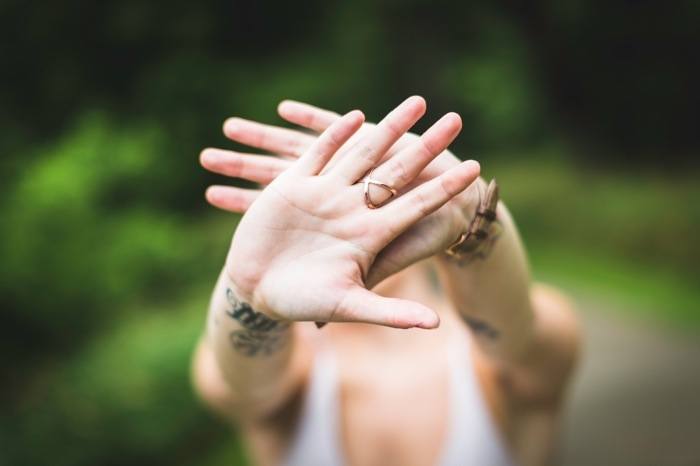Why “100% Preservative-Free” on Your Beauty Label Could Be a Red Flag
 In the wake of the great escape from parabens, it's getting a little confusing out there.
In the wake of the great escape from parabens, it's getting a little confusing out there.
You may already know how to read beauty labels. And have read about the risks associated with parabens, a group of preservatives used in many mainstream beauty products. So when you see natural beauty labels touting "100% preservative-free," it sounds great, right?
Not so fast, say experts. If you're talking about a product with any water in it, for example, a world without preservatives is a world with mold, bacteria, and microbial growth.
“I worry about a lot of those products that say [they're] preservative-free,"says California-based cosmetic chemist Bruce Akers, who works with natural and organic brands to create clean formulations. "If it’s oil-based that’s fine, but if it’s water-based it’s made by someone who’s either lying or doesn’t have the knowledge needed to describe what’s happening.”
So the question is not whether brands are using preservatives. It's how brands are preserving products—and whether their methods are as good-for-you as they can be.
Here are six things you need to know to navigate the beauty aisles without a chemistry degree—for a mold-free beauty regimen, thank you very much. And a cheat sheet to preservatives—both problematic and non-toxic. —Erin Hanafy
1. Some natural brands are removing all mention of preservatives from their labels because they "look bad" to label-readers. "Many so-called natural brands are beginning to do this, which has become a big problem," says Tara Foley, CEO of Boston-based natural beauty stores Follain, adding that they have parted ways with a few brands they'd previously stocked because of changes in labeling. "Preservatives are not all bad, and they need to be listed—along with everything else—so consumers can know what they're feeding their skin!" [See below for a list of natural preservatives.]
2. Fact: If a product has water in it, it needs a preservative. Foley says that if you see a product with water listed—but no preservatives—that should immediately raise a red flag. If something sets off your too-good-to-be-true detector, "reach out to the brand or retailer of the product with questions," says Foley, who encourages some good old-fashioned consumer push-back.

{{post.sponsorText}}
3. Beware of "greenwashing," or brands that represent themselves as cleaner than they are. One sign? They say they are not using parabens but instead are using formaldehyde slow-releasers: They appear as quaternium-15, DMDM hydantoin, imidazolidinyl urea, and diazolidinyl urea, says Shashi Batra, founder of San Francisco-based beauty market Credo Beauty.
4. There is concern in the industry about unpreserved or under-preserved cosmetics as well—and no, it's not coming from the big beauty brands. “It’s really important that we push people away from the idea of preservative-free,” says Nneka Leiba, deputy director of research for the Environmental Working Group (EWG). Truly preservative-free water-based products could present a public health problem if mold or bacteria was ingested through the eyes or mouth (eek!), she says. “What we really want to see is innovation and testing to find newer preservatives that are safer.”
5. Many beauty brands may not use parabens or other controversial preservatives in their formulations—but what about their suppliers? Not to make you all paranoid but “suppliers are not required disclose everything in their products, so beauty brands need to pay attention to make sure they are getting the cleanest possible ingredients,” says Malkan. “Many companies I know do their own testing (or at least spot testing) to make sure the raw ingredients they are buying from suppliers are not contaminated or preserved with chemicals.” But technically raw ingredients could arrive preserved and the finished the product might not mention this on the label, because a brand is ignorant of it or is exploiting the loophole.
6. Read labels—but with a skeptical eye. “The cosmetics industry is so poorly regulated that there can be a number of loopholes all over the place,” Leiba says. “Claims don’t mean anything. Natural doesn’t mean anything. None of these terms are regulated by the FDA—so it’s the wild west for companies being able to use any marketing terms they see fit.”
What does chemist Akers do? Actually, he makes his own soap. (He also grows a garden and keeps bees.) But there’s no need to go that far. "You have to trust the integrity of the company. If it’s a company you trust and feel that they’re doing the right thing and their heart’s in the right place, that’s the best way to judge," Akers says. "And hope that they’re honest."

How to tell the good from the bad when it comes to preservatives? Here's a cheat sheet:
Problematic Preservatives
In addition to parabens (a family of bacteria- and fungal-fighting preservatives linked to health risks) there are commonly used chemicals like formaldehyde-releasing DMDM hydantoin, quaternium-15, imidazolidinyl urea, diazolidinyl urea, synthetic “fragrance,” or others on the “dirty dozen” list are good indicators that the product could be cleaner, says Stacy Malkan, author of Not Just a Pretty Face: The Ugly Side of the Beauty Industry and a co-founder of the Campaign for Safe Cosmetics.
(And you can also look up products and ingredients on the Environmental Working Group's Skin Deep Database, which rates products and ingredients on a green-yellow-red scale of riskiness, or consult Follain's Restricted Ingredients List.)
Non-toxic Preservatives
Clean brands are tweaking their formulations to include more vegetable glycerin, neem oil, and 190-proof alcohol (which is drying, of course, but an effective preservative), says Shashi Batra, founder of Credo Beauty.
Smart brands are also adding antioxidants and essential oils with preservative properties—such as turmeric, rosemary, oregano, thyme, and tea tree—and they're even redesigning packaging to limit exposure to air (by using vacuum pumps), Batra says.
Follain founder Tara Foley's "safe preservatives" list includes food grade preservatives (like potassium sorbate and sodium benzoate); alcohols (organic ethanol, grape alcohol, benzyl alcohol, and witch hazel); and a short list of others that are sourced from plants (like gluconolactone, ethylhexyglycerin, triiostearyl citrate) and some that are synthetic but non-toxic preservatives, like dehydroacetic acid.
For more information, visit www.ewg.org and www.safecosmetics.org
More Reading
Paraben update: New research on beauty’s most problematic preservatives
3 fall moisturizers you can concoct in your kitchen
The 10 skin care commandments facialists live by
Loading More Posts...